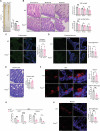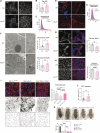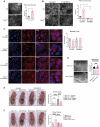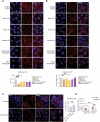Peroxisomal cholesterol metabolism regulates yap-signaling, which maintains intestinal epithelial barrier function and is altered in Crohn's disease
- PMID: 39069546
- PMCID: PMC11284232
- DOI: 10.1038/s41419-024-06925-x
Peroxisomal cholesterol metabolism regulates yap-signaling, which maintains intestinal epithelial barrier function and is altered in Crohn's disease
Abstract
Intestinal epithelial cells line the luminal surface to establish the intestinal barrier, where the cells play essential roles in the digestion of food, absorption of nutrients and water, protection from microbial infections, and maintaining symbiotic interactions with the commensal microbial populations. Maintaining and coordinating all these functions requires tight regulatory signaling, which is essential for intestinal homeostasis and organismal health. Dysfunction of intestinal epithelial cells, indeed, is linked to gastrointestinal disorders such as irritable bowel syndrome, inflammatory bowel disease, and gluten-related enteropathies. Emerging evidence suggests that peroxisome metabolic functions are crucial in maintaining intestinal epithelial cell functions and intestinal epithelium regeneration and, therefore, homeostasis. Here, we investigated the molecular mechanisms by which peroxisome metabolism impacts enteric health using the fruit fly Drosophila melanogaster and murine model organisms and clinical samples. We show that peroxisomes control cellular cholesterol, which in turn regulates the conserved yes-associated protein-signaling and contributes to intestinal epithelial structure and epithelial barrier function. Moreover, analysis of intestinal organoid cultures derived from biopsies of patients affected by Crohn's Disease revealed that the dysregulation of peroxisome number, excessive cellular cholesterol, and inhibition of Yap-signaling are markers of disease and could be novel diagnostic and/or therapeutic targets for treating Crohn's Disease. Our studies provided mechanistic insights on peroxisomal signaling in intestinal epithelial cell functions and identified cholesterol as a novel metabolic regulator of yes-associated protein-signaling in tissue homeostasis.
© 2024. The Author(s).
Conflict of interest statement
The authors declare no competing interests.
Figures






Similar articles
-
Development, validation and implementation of an in vitro model for the study of metabolic and immune function in normal and inflamed human colonic epithelium.Dan Med J. 2015 Jan;62(1):B4973. Dan Med J. 2015. PMID: 25557335 Review.
-
MicroRNA-590-5p Inhibits Intestinal Inflammation by Targeting YAP.J Crohns Colitis. 2018 Jul 30;12(8):993-1004. doi: 10.1093/ecco-jcc/jjy046. J Crohns Colitis. 2018. PMID: 29912317
-
Increased expression of yes-associated protein/YAP and transcriptional coactivator with PDZ-binding motif/TAZ activates intestinal fibroblasts to promote intestinal obstruction in Crohn's disease.EBioMedicine. 2021 Jul;69:103452. doi: 10.1016/j.ebiom.2021.103452. Epub 2021 Jun 26. EBioMedicine. 2021. PMID: 34186485 Free PMC article.
-
PRDM5 promotes the apoptosis of epithelial cells induced by IFN-γ during Crohn's disease.Pathol Res Pract. 2017 Jun;213(6):666-673. doi: 10.1016/j.prp.2016.12.004. Epub 2016 Dec 5. Pathol Res Pract. 2017. PMID: 28476379
-
Cytoskeletal Organization and Cell Polarity in the Pathogenesis of Crohn's Disease.Clin Rev Allergy Immunol. 2021 Apr;60(2):164-174. doi: 10.1007/s12016-020-08795-5. Clin Rev Allergy Immunol. 2021. PMID: 32474815 Review.
Cited by
-
Phage-displayed synthetic library and screening platform for nanobody discovery.Elife. 2025 Aug 1;14:RP105887. doi: 10.7554/eLife.105887. Elife. 2025. PMID: 40748049 Free PMC article.
-
Fecal Nervonic Acid as a Biomarker for Diagnosing and Monitoring Inflammatory Bowel Disease.Biomedicines. 2024 Dec 4;12(12):2764. doi: 10.3390/biomedicines12122764. Biomedicines. 2024. PMID: 39767671 Free PMC article.
-
Alterations in ether phospholipids metabolism activate the conserved UPR-Xbp1- PDIA3/ERp60 signaling to maintain intestinal homeostasis.iScience. 2025 Feb 4;28(3):111946. doi: 10.1016/j.isci.2025.111946. eCollection 2025 Mar 21. iScience. 2025. PMID: 40034858 Free PMC article.
-
Identifying inflammatory bowel disease subtypes: a comprehensive exploration of transcriptomic data and machine learning-based approaches.Therap Adv Gastroenterol. 2025 Aug 12;18:17562848251362391. doi: 10.1177/17562848251362391. eCollection 2025. Therap Adv Gastroenterol. 2025. PMID: 40808866 Free PMC article.
References
MeSH terms
Substances
Grants and funding
- RGPIN-2019-04083/Canadian Network for Research and Innovation in Machining Technology, Natural Sciences and Engineering Research Council of Canada (NSERC Canadian Network for Research and Innovation in Machining Technology)
- RGPIN-2019-04083/Canadian Network for Research and Innovation in Machining Technology, Natural Sciences and Engineering Research Council of Canada (NSERC Canadian Network for Research and Innovation in Machining Technology)
- PJT-169179/Gouvernement du Canada | Instituts de Recherche en Santé du Canada | CIHR Skin Research Training Centre (Skin Research Training Centre)
LinkOut - more resources
Full Text Sources
Medical
Molecular Biology Databases

